Gaming results
The addition of the NF200 brings Triple SLI or CrossFire possibilities to P55. We've taken the time to compare graphics performance to four other boards. The P55 line-up is comprised of two native PCI-E boards, the DFI M-ITX P55 and also BIOSTAR's TPOWER i55. We've also added EVGA's Classified 200 P55 motherboard, which also utilizes the NF200 to provide additional PCI-E lanes. Unlike MSI's Trinergy, EVGA chose to keep the first PEG slot CPU native (x16 single card bandwidth, x8 when any other PEG slot is used), and routed additional slots via the NF200. Finally, one cannot ignore X58, so we've added EVGA's Classified E760 motherboard to show how P55 stacks up against the native SLI capabilities of the Intel X58 IOH.
Far Cry 2
Featuring fantastic visuals courtesy of the Dunia Engine, this game also features one of the most impressive benchmark tools we have seen in a PC game. For single GPU results we set the performance feature set to Very High, graphics to High, and enabled DX10 with AA set to 2x. For dual and triple card SLI we used Ultra high settings with 4xAA and DX10. The in-game benchmark tool is utilized with the Ranch Small level as our test of choice.
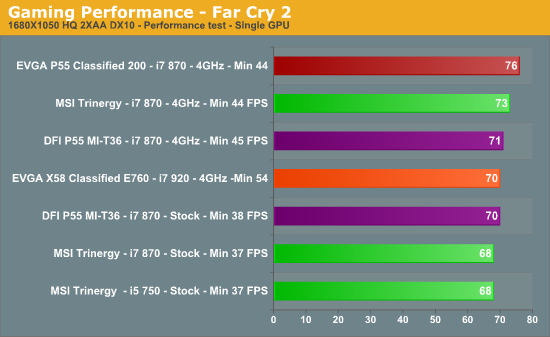
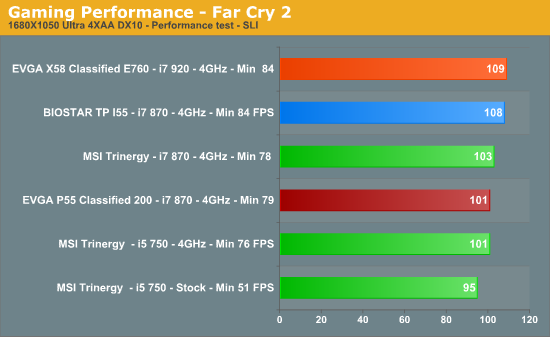
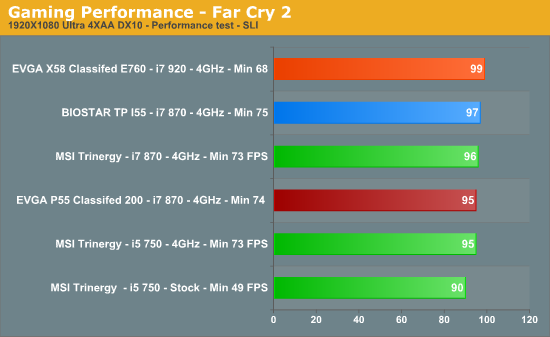
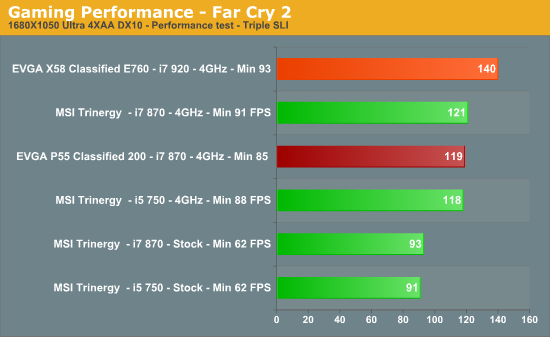
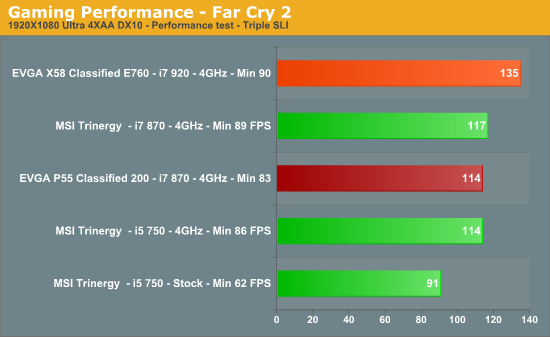
Single card performance favors all boards with native PCI-E solutions, leaving the Trinergy trailing by a couple of frames. The X58 pulls ahead in dual and Triple SLI performance in Far Cry 2, while the Trinergy is marginally ahead of the EVGA Classified 200. Note that native P55 operating at x8/x8 on the Biostar shows that x16 bandwidth is not essential for good performance.
Warhammer 40K: Dawn of War II
We are big fans of the Warhammer franchise, especially Dawn of War II. One of the latest RTS games in our library is also one of the more demanding titles on both the CPU and GPU. We crank all options to Ultra, enable AA, and then run the built-in performance benchmark for our result.
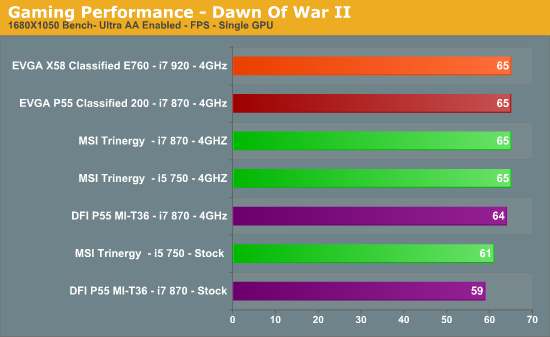
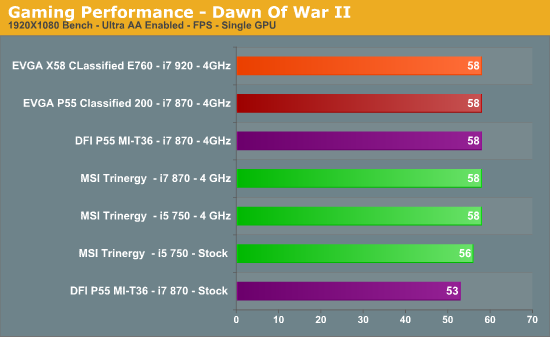
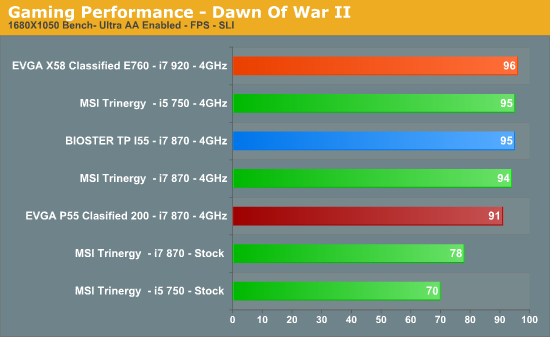
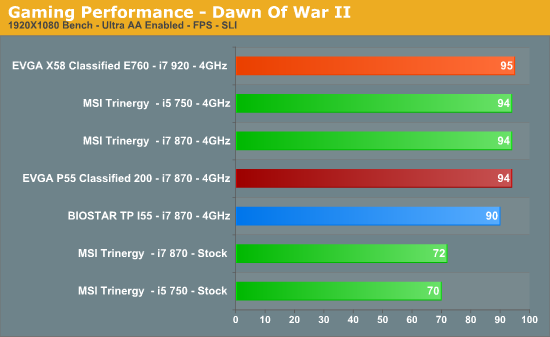
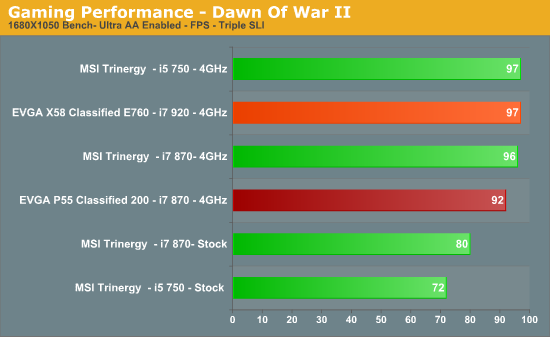
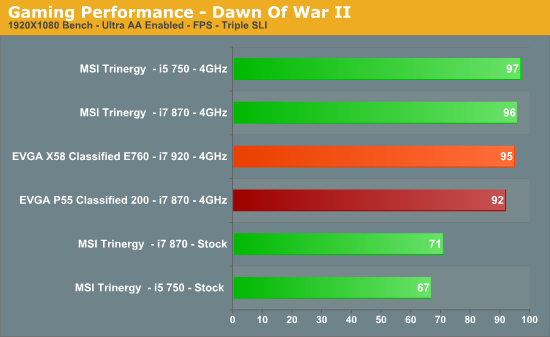
The Trinergy puts in a good show in all configurations during this benchmark. We found dual to triple card scaling was limited solely to minimum frame rates. The minimum FPS results were somewhat erratic at times though, showing wild swings between different batches of testing. Generally speaking, Triple SLI gives minimum frame rates in the region of 40 FPS at 1920X1080 resolution. In dual SLI mode, the averages drop to between 16~24 FPS. Single card mode sees minimum frame rates below 5 FPS in the worst case scenario at 1920X1080.
Resident Evil 5
For our final game benchmark we decided to add the Resident Evil 5's fixed time demo, running DX10, Ultra settings and 4xAA.

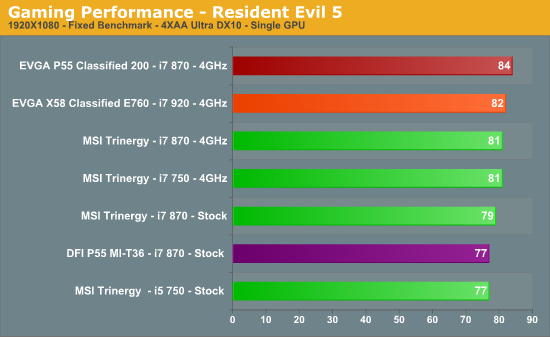
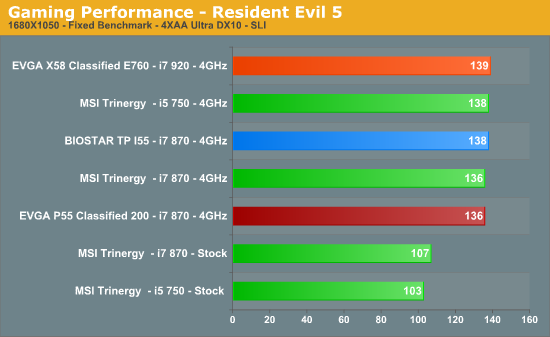

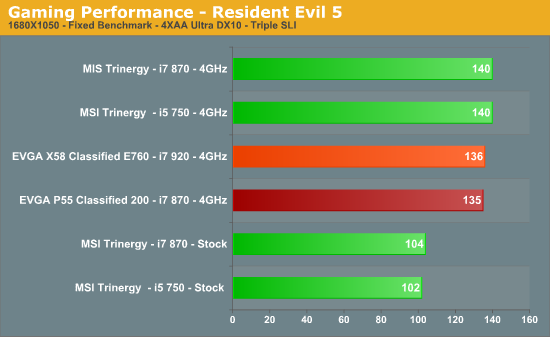
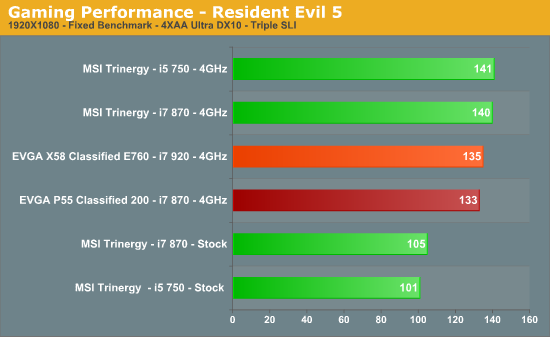
Capcom's engine seems to be CPU bound more than anything else, with all boards landing within a whisker of one another. Even X58 does not seem to show any real advantage in this benchmark.
3D Mark Vantage
For our final Triple SLI test, we thought it would be interesting to confirm scoring potential by looking at how each board fared when faced with the rigorous 3D and CPU tests of 3DMark Vantage using the High preset (1680X1050 resolution).
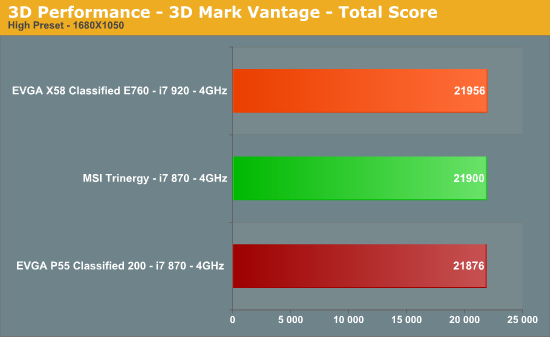
We expected more of a gap favoring X58 in this benchmark, but it appears the primary bottleneck is created by the GPUs here. Overall, the 3D benchmark scores in this section show that P55 running Triple SLI is not an embarrassment by any means.










12 Comments
View All Comments
a4mula - Wednesday, January 20, 2010 - link
I'm sorry, but did I miss the part of this article where we were trying to come to a consensus on the performance of the NF200 for tri configurations on the limited 1156? Why go with a board that doesn't even come close to saturating the 8x bandwidth limit. Trifire 5870's, QuadfireX dual 5970's. We learned absolutely nothing other than the 1156's 16x pcie to die lanes still bottleneck in a 275 trisli. Where are the real reviews of NF200 + 1156?dia - Wednesday, January 27, 2010 - link
I think you've answered your own question. If 275's are bottlenecked somewhat; going by the fact they 'dont saturate 8x bandwidth', how do you think the higher performance cards will fare?You're probably looking at a 2~5% performance drop maximum on the current cards.
DeepThought86 - Wednesday, December 23, 2009 - link
How about adding stability to all your reviews. Run for 24 with the highest TDP proc that's officlally supported along with the highest TDP video cards that will fit, see if it burns up or not.Rajinder Gill - Thursday, December 24, 2009 - link
I usually run LinX for the stability testing stuff overclocked (along with plenty of application testing). Which is plenty IMHO.Holly - Saturday, December 26, 2009 - link
Well, to be honest, it is and it isn't... These days systems are way too complex to be able to draw really good stability conclusion...Just an example... My old E6300 (the 1.86GHz one) runs perfectly stable 24/7 on 2.975GHz (7x425) at 1.2V flat... and it runs without any troubles... games, C++ compilations, complex Maple calculations...
You'd say it runs perfect... well until I installed SSSE3 optimized Seti@Home application (instead of normal one that was running for like half year on this machine)... and guess what... CPU temperature went up by 5°C (water cooled) compared to previous top and computer went BSOD in couple of minutes. To compensate I had to either drop FSB to 410MHz or raise voltage to 1.224V.
Long story short... we can't hope to be able to really load the cpu 100%... yes, it doesn't idle when you stress it, but in fact how big part of the core is actualy working and how big part is taking a nap?
I would suggest trying mentioned optimized S@H on the system you consider stable (I am not saying it will crash, but the possibility is there)... We use the app at my friend's computer shop and usualy if there is a problem with hardware the machine goes BSOD in few minutes of testing... It's a bit drastic but very fast way to check failed OC.
Merry Xmas,
Holly
sgtpokey - Wednesday, December 23, 2009 - link
Dear Anandtech Staff,You don't have to invent your own nomenclature (OVERVIEW/CONCLUSIONN) for having an "Executive Summary" (or shorten it to "Summary" if you want) leading off the analytical article.
Calling anything other than the concluding section a "Conclusion" is a bit jarring.
Thank you for your time,
sgtpokey
Etern205 - Wednesday, December 23, 2009 - link
When AT first introduced this "overview/conclusion", I can't believe how many readers actually agree with this type of approach. Sure AT is a great site, but it does not mean you will need to agree on everything they do.I still prefer the old fart method
intro-->article w/pics-->benchies-->conclusion/author's pov
strikeback03 - Wednesday, December 23, 2009 - link
They probably have some page hit numbers they could pull out, but I wouldn't be at all surprised to find out that the majority of readers hit the conclusion (whether at beginning or end) before reading any graphs or descriptive text.As far as the board goes, meh, it seems to be a relatively competent, really expensive board mostly designed to stroke the companies' ego rather than provide something useful to 99% of potential users
Kenenniah - Wednesday, December 23, 2009 - link
Conclusion can easily mean the reviewer's conclusion and not the conclusion of the article itself.at80eighty - Wednesday, December 23, 2009 - link
I'm undecided about AT's new "draw your own conclusions' approach